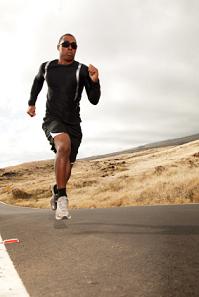Running Injuries
Can you think of a time while driving along any highway or road that you haven't seen at least one jogger? I doubt it. Most of the time there are many diligent athletes working the roadways in search of better fitness, health and performance.
|
Most of the time an occasional sore muscle is the only adverse result, and only severe weather will stop the dedicated runner from completing his or her mileage. However, once in a while, true extremity pain will disable these gladiators of the roadway. Running injuries most commonly involve the lower extremity or back. A great majority of problems are what the medical community refers to as "overuse" injuries. These frequently includes tendinitis, stress fractures and blisters. Preventive care and treatment are geared toward these problems. The knee, leg, ankle and foot, take the brunt of running abuse. In the knee, tendinitis typically involves the ilia-tibial band (ITB) on the outside of the knee and pes anserine (PES) on the inside. Patella-femoral syndrome is responsible for pain located in the front of the knee. ITB and PES tendinitis is especially sensitive to running shoes, in that a higher or lower arch support will rotate the knee, affecting these tendons. |

|
In the leg, "shin splints" are common but must be more specifically diagnosed for adequate treatment. Shin splints actually are one of the following: exertional compartment syndrome (leg muscle pressure), posterior tibialitis, or stress fracture. The ankle is often affected with Achilles tendinitis. Shoe heel height can be adjusted to help exertional compartment syndrome and Achilles tendinitis.
High heels help the Achilles' tendon, and low heels help the compartment syndrome. In addition, shoe arch support is important to control the posterior tibialis tendon, whose job is to support the arch of the foot.
A stress fracture in either the hip, shin, or foot requires strict rest. It also usually requires special testing to diagnose.
Blisters, of course, are very common in the foot and often are associated with recent changes in socks or shoes. Other problems include sore foot bones (metatarsalgia) and painful nerves (neuroma), both of which may respond to arch supports and cushioning.
Preventive conditioning is key to avoiding running problems and should be a part of every runner's routine. Pre-exercise stretching or a gentle warm-up (walk or slow jog) will get the anatomy ready to handle the stress of running. A stretching program should include the thigh muscles, hamstrings, shins and calves.
Of course, proper running shoes, terrain and training techniques should be utilized. If injury rears its ugly head, one should remember R.I.C.E. (Rest, ice, compression and elevation) as a frontline of defense. Continued pain should be evaluated by your podiatrist.